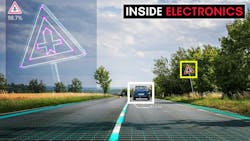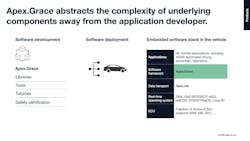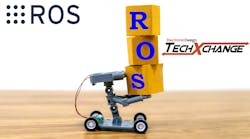Using the Robot Operating System for Automotive Applications
What you’ll learn:
- What is the Robot Operating System (ROS)?
- Why use ROS in cars?
- What is Apex.ai’s part in making ROS work in automotive applications?
The Robot Operating System (ROS) is middleware that can be used for almost any type of robotic platform, including self-driving cars. ROS is an open-source system hosted at ROS.org. It runs top conventional operating systems like Linux and Windows and has been employed in many robotic applications.
ROS can also work with real-time operating systems (RTOS) like QNX and Green Hills Software’s Integrity. In many cases, the target application may require certification as with automotive applications. Here, the RTOS is not the only component that must be certified—the middleware, such as ROS, and the application are part of this process.
Apex.ai has a version of ROS that can work in safety-critical applications. This is actually a combination of systems that include Apex.Grace, which is the software framework, and Apex.Ida, which provides the underlying data-transport system (see figure).
In this episode of Inside Electronics, I talked with Jan Becker, CEO at Apex.ai, about ROS and how it’s being used in automotive applications, as well as issues related to certification.
SHOW NOTES
00:28 – Apex.AI
02:00 – Robot Operating System (ROS)
04:56 – Hardened Communication System
07:11 – Tools for Automotive Applications
08:42 – What Can Run Under The Middleware
10:35 – Debugging & Analysis
>>Check out these TechXchanges for more podcasts and similar articles and videos
About the Author
William G. Wong
Senior Content Director - Electronic Design and Microwaves & RF
I am Editor of Electronic Design focusing on embedded, software, and systems. As Senior Content Director, I also manage Microwaves & RF and I work with a great team of editors to provide engineers, programmers, developers and technical managers with interesting and useful articles and videos on a regular basis. Check out our free newsletters to see the latest content.
You can send press releases for new products for possible coverage on the website. I am also interested in receiving contributed articles for publishing on our website. Use our template and send to me along with a signed release form.
Check out my blog, AltEmbedded on Electronic Design, as well as his latest articles on this site that are listed below.
You can visit my social media via these links:
- AltEmbedded on Electronic Design
- Bill Wong on Facebook
- @AltEmbedded on Twitter
- Bill Wong on LinkedIn
I earned a Bachelor of Electrical Engineering at the Georgia Institute of Technology and a Masters in Computer Science from Rutgers University. I still do a bit of programming using everything from C and C++ to Rust and Ada/SPARK. I do a bit of PHP programming for Drupal websites. I have posted a few Drupal modules.
I still get a hand on software and electronic hardware. Some of this can be found on our Kit Close-Up video series. You can also see me on many of our TechXchange Talk videos. I am interested in a range of projects from robotics to artificial intelligence.
Jan Becker
CEO and Co-Founder, Apex.AI
Jan Becker is the CEO and Co-Founder of Apex.AI, Inc. He is also the Managing Director of Apex.AI GmbH in Germany, the chairman of the board of Apex.AI Sweden AB, a Managing Director of Apex.AI Korea Limited and a Representative Member of Apex.AI Japan GK.
Before founding Apex.AI, he was Senior Director at Faraday Future, responsible for Autonomous Driving, and Director at Robert Bosch LLC, responsible for Automated Driving in North America.
Since 2010, Jan has been a Lecturer at Stanford University on autonomous vehicles and driver assistance. Previously, he was a visiting scholar at the University’s Artificial Intelligence Lab and a member of the Stanford Racing Team for the 2007 DARPA Urban Challenge.
Jan received the Software-Defined Vehicle Innovator (SDVI) of the Year award from MotorTrend in 2024 and was listed as one of the top “60 people driving the self-driving movement” by Automotive News in 2016.
Jan earned a Ph.D. in control engineering from the Technical University of Braunschweig, Germany, a master’s degree in mechanical and aerospace engineering from the State University of New York at Buffalo, USA, and a master’s degree in electrical engineering from the Technical University of Darmstadt, Germany.




